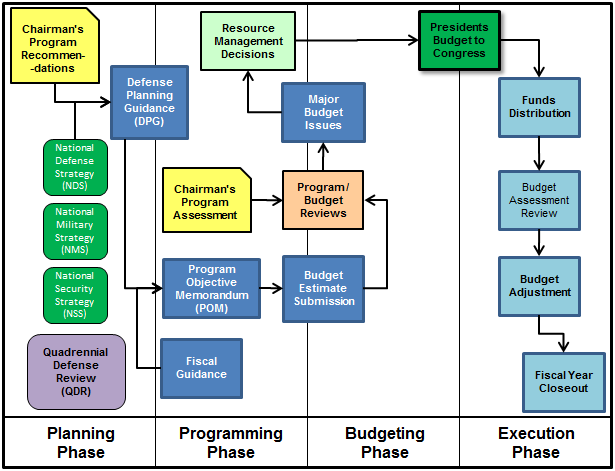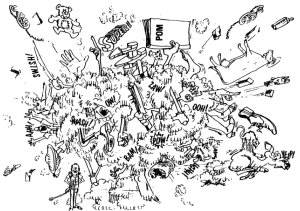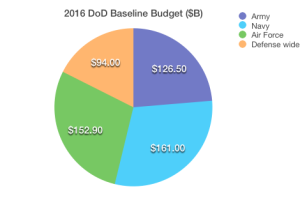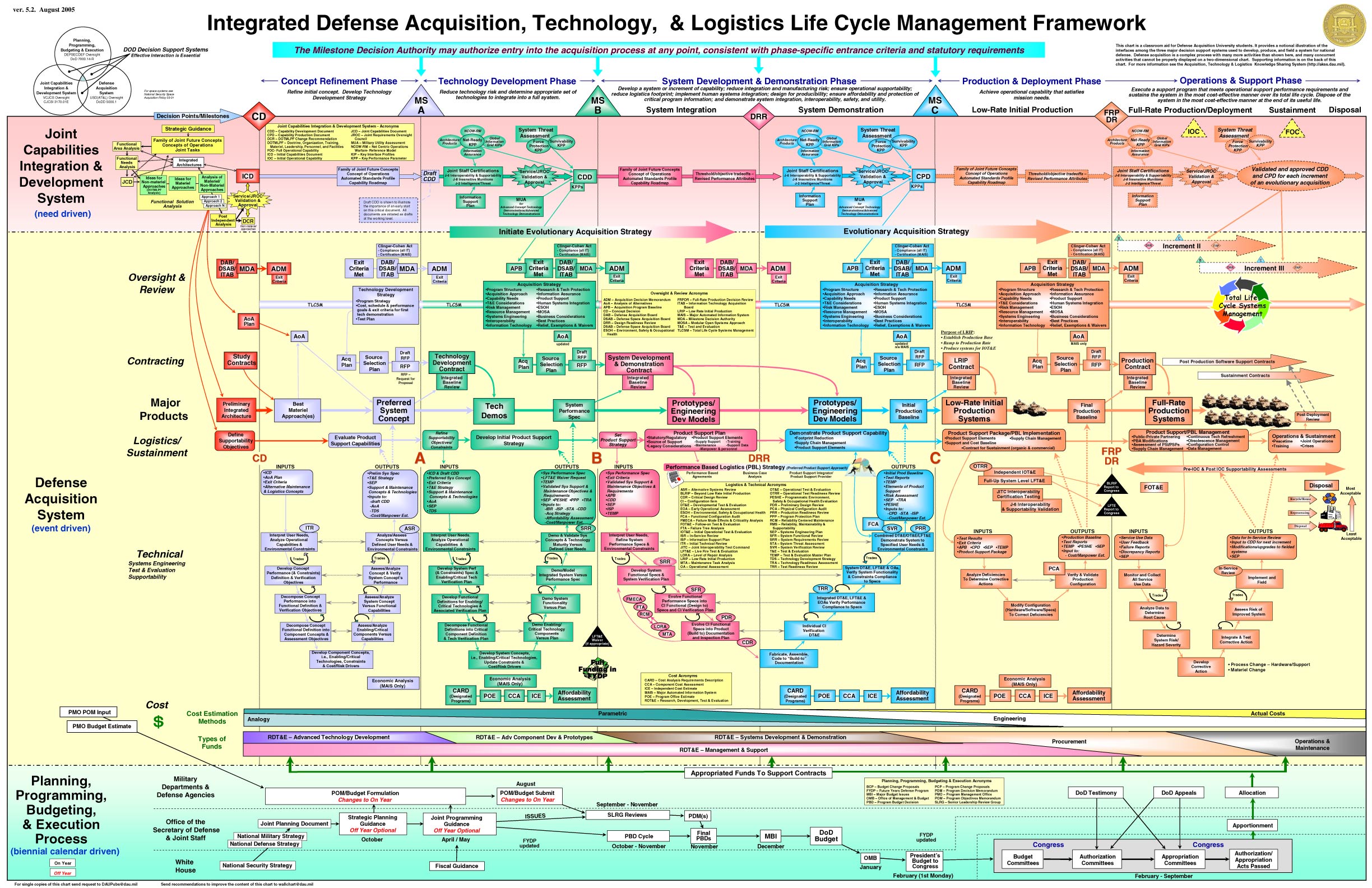I guess it’s that time of year when one must talk about all things budget. And since I am only a small gnu within the herd, I too will opine on the obvious. Several thoughts came to mind as I was reading some of the commentary on the budget. It’s always fun to read the DoD press releases and to see the latest spin. How well-educated and experienced people can say some of this stuff with a straight face is a mystery to me. Take the DoD article on its press site today, “Budget Request Balances Today’s Needs Against Tomorrow’s Threats.” The article is a summary of a press conference held by DoD Comptroller, Mike McCord. I love his characterization of the budget: “although planners were aware of financial constraints, the budget is a strategy-driven construct.” Translation–we ignored the budget caps. As an aside, you all know how I hate the way the Pentagon takes common words and complicates them…like “construct“. Don’t they mean plan? I confess that I used to be as bad as the next Pentagonian in inflating words to add an air of sophistication and deep-thoughtedness to them. The “construct” word stands out in my mind because I used it one day while briefing the Chairman of the House Armed Services Committee, Ike Skelton. He stopped me and asked, “What the heck does that mean…construct’? I replied, ” Well, you know…the product of the assimilation of a multitude of facts and non-facts into a non-coherent stream of pseudo-strategy designed to defend an un-defendable position.” Mr. Skelton replied,” Just say plan. Don’t make it so complicated with strange words.” AMEN…..And after that, I tried to avoid Pentagonisms like the plague.
Once again this budget side-steps many of the large issues, like the runaway Joint Strike Fighter budget and focuses in on the marginal stuff…TRICARE rate hikes, cutting Commissary hours, as well as proposing the impossible…base closure, A-10 retirement and the like.
But that’s not the subject of today’s blog, so I will move on from that unpleasantness…….Today’s topic is about HOW the Pentagon arrives at its budget. Of course, it’s fairly common knowledge to this audience that it uses the Planning, Programming Budgeting and Execution (PPBE) system.

A very regimented (or so it used to be) process with a clearly and elegantly articulated set of roles, rules, responsibilities, and schedules. Here is a link to a very well written Army War College paper by LTC Thomas T. Frazier on the history of PPBE system (originally PPBS). Here’s the Cliff Notes version. PPBS was instituted by Secretary of Defense Robert McNamara in the early 60’s because his opinion what that there was no clear process of deciding what to fund and how much to fund. Here is a link to my presentation on how the PPBE system works. Over the last few years the process has morphed from the nice neat process because of Continuing Resolutions, shutdowns, furloughs, war and all manner other issue. Anyway, Secretary McNamara felt that the Pentagon budget process was really one of Incrementalism…just adding more money each year with little thought of where it was going. Interestingly, the things which drove the change came down to six flaws in 1961:
- Budget decisions were largely independent of plans
- Duplication of effort among the Services
- Service budgets prepared largely independent of one another with little balancing across Services
- Services felt they were entitled to a fixed share of the budget, regardless of contribution to overall defense needs
- The budget process focused on next year, with little regard for future impacts
- Little analysis behind the numbers
Sound familiar? I submit that all of these factors exist today to some degree or another, perhaps for different reasons than in 1961, but they exist nonetheless. That’s why I think it’s time for a serious discussion about changing the process. Over the past half-century we have fallen back into some very bad habits. They were good reasons for change then, and equally good for change now.

Many would say today’s budgets are very independent of plans. Despite the efforts of the 24,000 or so Pentagon workers, in the end the budgets are determined in large measure by political decisions. I note that the elegant planning process in the Pentagon has recommended decommissioning the A-10, laying up Aegis Cruisers, another round of BRAC, and on and on. These proposals were developed by thousands of planners chewing up millions of man hours, yet the analysis is ignored by the Congress. As the Navy’s N8 I came to the conclusion that at any given moment probably 90% of the people in the Pentagon are working on some part of the budget. But to what ends? At the end of the day, the budget never changes more than about 1% -1.5%, despite the hundreds of thousands of man hours devoted to changing it? Why bother? Given there is so little change, why not stop all the madness of millions of minor budget data base changes which in the end have less than a 1% impact? We could get by with half the people in the Pentagon and let them do something more constructive.
There’s no doubt that we have still to tackle the duplication of effort issue. We still have an unexplainable excess of tactical aircraft in the Air Force, Navy and Marine Corps because no one is willing to give the mission up. Look how much money that one is costing us in the guise of the JSF.
With regard to independent budget development by the Services, that’s still a problem too. How often do you think Air Force budgeteers sit down with the Navy guys to go over their current budget plans…Answer: never…It’s not until OSD gets the budgets that the Services find out what each is really up to. Heck, the Marines don’t share much of their budget with the Navy until end-game, and they are in the same Department!
The one-third rule ( every Service is entitled to roughly a third of the DoD budget) is still alive and well in the Pentagon. But because of the growth of the Fourth Estate (DoD agencies and combatant commands according to SECDEF nominee Ash Carter) the pie has been further divided. It’s almost the one-fourth rule now. What’s up with that? The process will never work if one assumes equal shares for all.
As far as budgets being focused on one year, despite the best efforts of DoD to lay in a 5 year plan, it is essentially redone every year. I used to submit the Navy’s 30 Year Shipbuilding plan almost every year with major changes. What kind of long-range plan is that? The truth is that with the way we fight the budget wars from year to year, coupled with the inability of the Congress to regularly and reliably pass funding and authorization legislation, DoD has no choice but to focus on one year. It has become so challenging to execute the budget and build several (the base budget, the sequester budget, the President’s budget, Overseas Contingency Ops budget) that it is impossible to focus on later years.
Perhaps the bright spot is the improvement in the department’s analytical capabilities. We certainly have a world class capability, which produces fantastic analysis. The problem is that it is sometimes ignored by those that matter..either in the Pentagon or on the Hill. To be fair, I should say the analysis is selectively ignored. If the analysis supports your program, it’s cited again and again. If it doesn’t, then one has to play the “experience” or “uncertainty” card. You have all heard that argument: “It’s an uncertain and dangerous world and the analysis does not adequately take that into account. We must rely on our experience and intuition.”
Of course, the PPBE is only one way in which the DoD manages its money. A few years back I gave a presentation on “How DoD Manages Money” in which I cited the following techniques:
- Management by topline
- Management using the “More Money” rule
- Management by appropriation
- Management by Service
- Management by rice bowls
- Management using the 1/3 Rule
- Management by congressional district
- Management by PPBE
It’s too complicated to explain here, but check out the presentation. Even though it was done in 2009, I think it’s relevant today.
So that’s my rail of the day. We need to change the PPBE. I don’t know how. I am not that smart. Maybe some smart combination of the above management systems… I do know that the same reasons we decided to re-twicker the DoD budget process in 1961 exist today. We should convene a group of smart folks (and not just old fogies like me who got us into this mess in the first place) to consider how to develop a process which eliminates the 1961 reasons. It’s time for some new and innovative thinking, done by all interested parties (Congress, DoD, Administration) on how to fix the problem.


